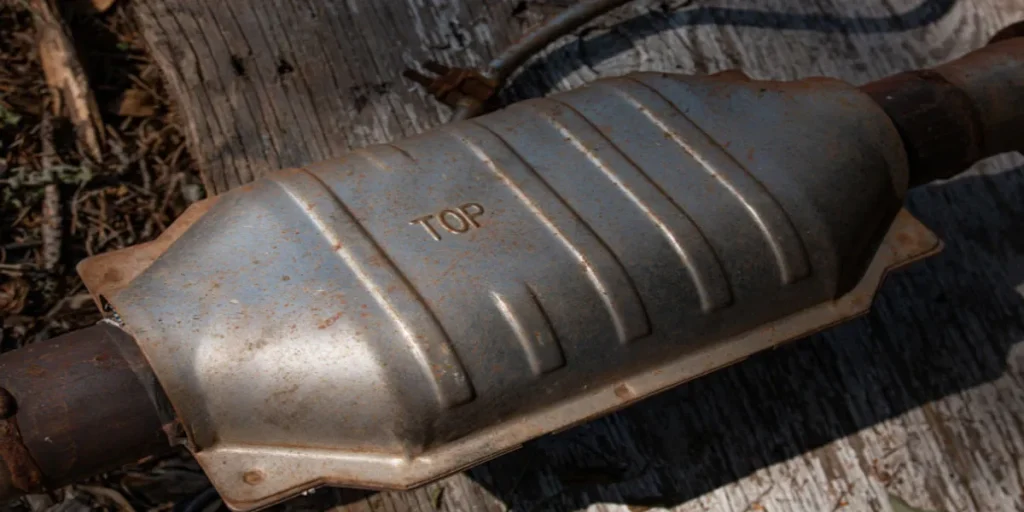A catalytic converter typically weighs between 3 to 50 pounds (1.4 to 22.7 kilograms). Compact cars generally have lighter catalytic converters, whereas larger vehicles have heavier ones.
Understanding the weight of a catalytic converter is crucial for both auto mechanics and vehicle owners.
This component, essential for reducing harmful emissions, is a key piece of a car’s exhaust system. Its weight can vary significantly based on the type of vehicle it’s designed for.
The weight also depends on the construction materials, which include precious metals like platinum, palladium, and rhodium.
These metals are the primary reason catalytic converters are often targeted by thieves. Knowing the specifics of your vehicle’s catalytic converter can help in assessing its value and ensuring appropriate handling during replacements or recycling efforts.
Recent advancements in auto technology continue to impact the design and consequently the weight of catalytic converters, adapting them for improved emissions control and efficiency.
Essential Emission Control Devices

Catalytic converters play a crucial role in modern vehicles, ensuring that harmful emissions are reduced before they escape into the atmosphere.
These devices are more than just auto parts; they symbolize a commitment to environmental responsibility.
A key question many car owners have is, “How much does a catalytic converter weigh?” The weight of a catalytic converter varies but is important for both vehicle performance and emission control functionality.
Role In Reducing Pollution
The primary function of a catalytic converter is to minimize environmental impact by transforming exhaust pollutants into less harmful substances.
The science behind this is both fascinating and critical for clean air initiatives. Understanding its importance helps appreciate the sophistication behind vehicle engineering.
- Converts carbon monoxide into carbon dioxide
- Changes hydrocarbons into water and carbon dioxide
- Reduces nitrogen oxides back into nitrogen and oxygen
Key Components
The anatomy of a catalytic converter is complex, with multiple parts working in unison. Let’s break down the key components:
| Component | Function | Material |
|---|---|---|
| Catalyst | Speeds up the chemical reactions | Platinum, Palladium, Rhodium |
| Substrate | Supports the catalyst | Ceramic or Metal |
| Housing | Encloses the components | Stainless Steel |
Each component must withstand extreme temperatures and mechanical stresses, contributing to the overall weight and durability of the catalytic converter.
Diving Into The Weight Range

Understanding the weight of a catalytic converter is vital for scrap dealers, mechanics, and environmentally conscious car owners.
It is a critical component of a car’s exhaust system. Let’s dive deep into how much these devices generally weigh.
Average Weights
Catalytic converters come in different sizes and weights, varying based on the vehicle type they are designed for.
- Small cars typically have lighter converters that weigh around 2 to 6 pounds.
- Mid-sized cars may have converters weighing between 5 to 8 pounds.
- Large vehicles, like trucks and SUVs, house heavier converters with weights possibly exceeding 12 pounds.
Factors Affecting Weight
Several aspects determine a catalytic converter’s weight:
| Factor | Description |
|---|---|
| Material Used | Catalytic converters contain precious metals like platinum, palladium, or rhodium which add to their weight. |
| Size of Vehicle | Larger vehicles need bigger converters to handle more exhaust gases, resulting in a heavier unit. |
| Converter Type | OEM parts differ from aftermarket parts, potentially causing substantial variations in weight. |
| Exhaust System Design | Some systems integrate the catalytic converter compactly within the design, affecting its weight and size. |
Material Makeup
The heart of every catalytic converter is its material makeup. Different materials contribute to a converter’s efficiency and durability.
These materials also determine the weight of the unit. By understanding what goes into a catalytic converter, car owners can better appreciate the technology that keeps their vehicles running clean.
Metals Used
Catalytic converters contain a variety of precious metals. These metals play a crucial role in the reduction of vehicle emissions. Let’s explore the most common ones:
- Platinum: This is a key reactive agent.
- Palladium: Aids the oxidation of harmful gases.
- Rhodium: Breaks down nitrogen oxides.
Impact On Weight
The metals within a catalytic converter greatly impact its overall weight. Here’s how:
| Metal | Weight Contribution |
|---|---|
| Platinum | Heavy, adds significant weight. |
| Palladium | Lighter than platinum. |
| Rhodium | Very dense, influential in weight. |
Collectively, the use of these metals can make a catalytic converter weigh between 3 and 7 pounds for smaller cars.
Meanwhile, larger vehicles may have converters that range from 7 to 20 pounds, depending on the model and the amount of metals used within them.
Variances Across Vehicle Types
The weight of a catalytic converter can vary greatly depending on the type of vehicle.
This variability is significant due to the different sizes, engine capacities, and emissions requirements that each kind of vehicle must adhere to.
In the following sections, we’ll explore these differences for compact cars, SUVs, and heavy-duty versus light-duty vehicles.
Compact Cars Vs. Suvs
The contrast in weight between the catalytic converters of compact cars and SUVs can be quite pronounced.
Compact car converters generally weigh less because these vehicles have smaller engines and require less exhaust processing.
On the other hand, SUVs come with bulkier converters due to their larger engines and consequently more substantial exhaust systems. Here’s a quick overview:
- Compact Cars: Typically, 2 to 4 kg
- SUVs: Often, 4 to 6 kg
Heavy-duty Versus Light-duty Vehicles
When comparing heavy-duty vehicles, like trucks and buses, with light-duty vehicles, such as sedans and hatchbacks, the difference in catalytic converter weight is even more significant.
Heavy-duty vehicles use larger and more robust catalytic converters to handle the higher exhaust volumes. Below is a simple breakdown:
| Vehicle Type | Average Catalytic Converter Weight |
|---|---|
| Light-Duty Vehicles | 3 to 5 kg |
| Heavy-Duty Vehicles | 8 to 20 kg |
When Weight Matters?
Car experts and enthusiasts often overlook a crucial component: the catalytic converter. Knowing the weight of this essential device can impact many areas. Let’s dive into why weight matters.
Shipping And Handling
The weight of a catalytic converter is vital during shipping and handling. Heavier converters can increase shipping costs. This is important for suppliers and customers.
Improved handling can result from knowing the weight. This helps in planning and reduces the risk of injury from lifting.
Here are key points for shipping:
- Cost calculation: Weight directly influences shipping price.
- Packaging needs: Heavier items need stronger packaging materials.
- Carrier selection: Some carriers have weight limits or different rates.
Performance Implications
A catalytic converter’s weight can also affect a vehicle’s performance. A lighter converter could mean better vehicle efficiency and handling.
| Converter Weight | Performance Impact |
|---|---|
| Lightweight | Increases agility and fuel efficiency |
| Standard Weight | Neutral, balanced performance |
| Heavyweight | May decrease acceleration and agility |
Less weight often means better speed and reduced fuel consumption. It contributes to an overall enhanced driving experience.
Recycling And Its Benefits
The importance of recycling spans various materials, including catalytic converters from vehicles.
Often heavy, a catalytic converter’s weight is significant due to the precious metals it contains.
Recycling catalytic converters not only conserves these valuable resources but also carries substantial environmental benefits.
Valuable Metals Recovery
Inside a catalytic converter, a treasure trove of metals awaits. Metals such as platinum, palladium, and rhodium play a crucial role in the converter’s operation.
These metals are not only scarce but highly sought after in various industries, including jewelry and electronics.
Recycling catalytic converters means recovering these valuable metals. It reduces the need to mine fresh material, saving energy and reducing environmental strain.
The process involves sorting, shearing, and then extracting the metals, which can then re-enter the supply chain, minimizing waste.
Environmental Impact Of Recycling
The benefits of recycling catalytic converters extend beyond just recovering precious metals. By recycling, we limit harmful mining and processing activities.
This translates into reduced greenhouse gas emissions and conservation of natural habitats.
Furthermore, the correct disposal of catalytic converters prevents the release of toxic substances into the environment.
By choosing to recycle, we ensure that these potent compounds are managed safely and responsibly, alleviating potential environmental harm.
| Benefit | Explanation |
|---|---|
| Conservation of Metals | Precious metals are reused, reducing the need for new mining. |
| Energy Savings | Less energy is used in metal recovery than in raw material processing. |
| Environmental Protection | Reduced emissions and habitat disturbance from mining activities. |
| Toxicity Management | Proper disposal prevents release of harmful compounds. |
FAQs About the Weight of a Catalytic Converter
What Is The Average Weight Of Catalytic Converters?
The average weight of catalytic converters ranges from 3 to 7 pounds, depending on the vehicular model and manufacturer.
Are Heavier Catalytic Converters More Efficient?
No, the efficiency of catalytic converters is not dependent on weight but on the precious metal content and catalyst design.
How Does Vehicle Type Affect Converter Weight?
Vehicle type affects converter weight as larger vehicles, like trucks, often require larger and heavier catalytic converters to handle more exhaust gases.
Can Weight Impact Catalytic Converter Replacement Cost?
Yes, heavier catalytic converters may cost more due to higher amounts of precious metals like platinum, palladium, and rhodium being present.
Conclusion
Understanding the weight of a catalytic converter is crucial for auto enthusiasts and professionals alike.
These essential emissions control devices vary in weight, typically falling between 3 to 7 pounds for smaller cars and up to 25 pounds for larger vehicles.
Proper disposal and recycling are key, ensuring environmental responsibility alongside automotive maintenance. Remember, a well-functioning converter contributes to a healthier planet.
Resources:
https://www.uti.edu/blog/automotive/catalytic-converter
https://www.bar.ca.gov/consumer/smog-check-program/catalytic-converter-theft
